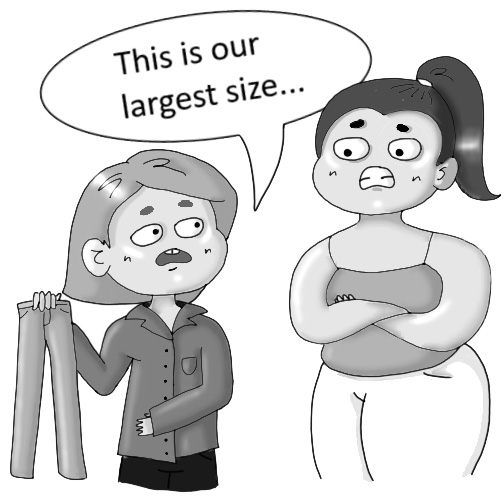

Browsing for clothes is often an enjoyable experience, but finding pieces that fit can be difficult. For the average American woman, who, according to Plunkett Research, is 5’4 and wears size 14-18, this is especially true, as she falls into the plus-size category, a range entertained by only 2.3 percent of women’s apparel in America’s largest multi-brand retailers.
“I think size inclusivity is something that all clothing brands should have because they should let everyone wear their brand,” said sophomore Amber Yeh. “There are a lot of brands that are inclusive with their clothing, but [the] majority [of them cater] towards skinnier body types.”
Subscription services like Gwynnie Bee and Fabletics incorporate a broad range of sizes into their clothing, from 0-32 and 0-24 respectively. However, the majority of luxury brands, as well as most casual wear brands do not carry any extended sizes.
“I went into Forever 21 and I noticed that even their largest large [in the regular size section] was quite small,” said junior Emily Fang. “They have a larger size section in the store now, but in the past, [the selection] used to be quite narrow.”
Yeh believes that lack of initiative to expand sizes is attributed to images that brands strive to uphold.
“It might be because [certain brands] only want people who [meet] society’s standards to wear their clothes,” Yeh said. “I do believe that [those brands] are missing out on a lot … because plus size people won’t be able to buy clothes.”
According to market research firm National Purchase Diary, plus-size sales reached 21.4 billion in 2016 with an annual growth rate of 6 percent, but despite this, many clothing companies have not incorporated plus-size apparel into their lines.
Sophomore Victoria Ly believes that it may be difficult for brands to accommodate all body types.
“Companies can’t get every single size out there,” Ly said. “But I think [that with] the way they size some things, they just aren’t trying to be inclusive … They have a target market of people that they want to buy their clothes.”
Creating larger sizes requires brands to use more fabric, designs and models. According to Racked, Christine Hunsicker, the founder of Gwynie Bee, has estimated that it costs about $500,000 to incorporate larger size lines into their brand.
“There [are] shops and brands that have started to just specialize in plus-size,” Ly said. “I think that’s good because they know their market, and plus-size people will buy from them.”
Brands like Ashley Stewart and Eloquii have emerged in past years with exclusively plus-size lines. Fang believes that social media promotes dual views on size inclusivity.
“[Social media] encourages girls especially to become thinner, sometimes to an unhealthy extent,” Fang said. “Sometimes, it’s quite negative, but other times, there are really nice role models on Instagram who have curves, but they still model, [and] they’re still proud of their bodies, which is really what our generation needs nowadays.”
Social media influencers like Ashley Graham help spread body positivity through their platforms by posting diverse photos and addressing issues on the lack of representation of all body types in the media.
Yeh believes that the issue of non-inclusive sizing could be addressed through spreading awareness.
“I feel like letting people know about how this is an issue is one of the things that should be done,” Yeh said. “Also, just letting the company know that not being size inclusive is not a good thing … [and] may offend people with other body types.”
Although the clothing industry has made progress, it is still far from achieving complete size inclusivity. Perhaps through collective efforts and appropriate funding, people of all sizes will one day feel like they have a place to shop and thrive in.




